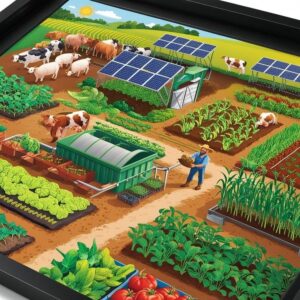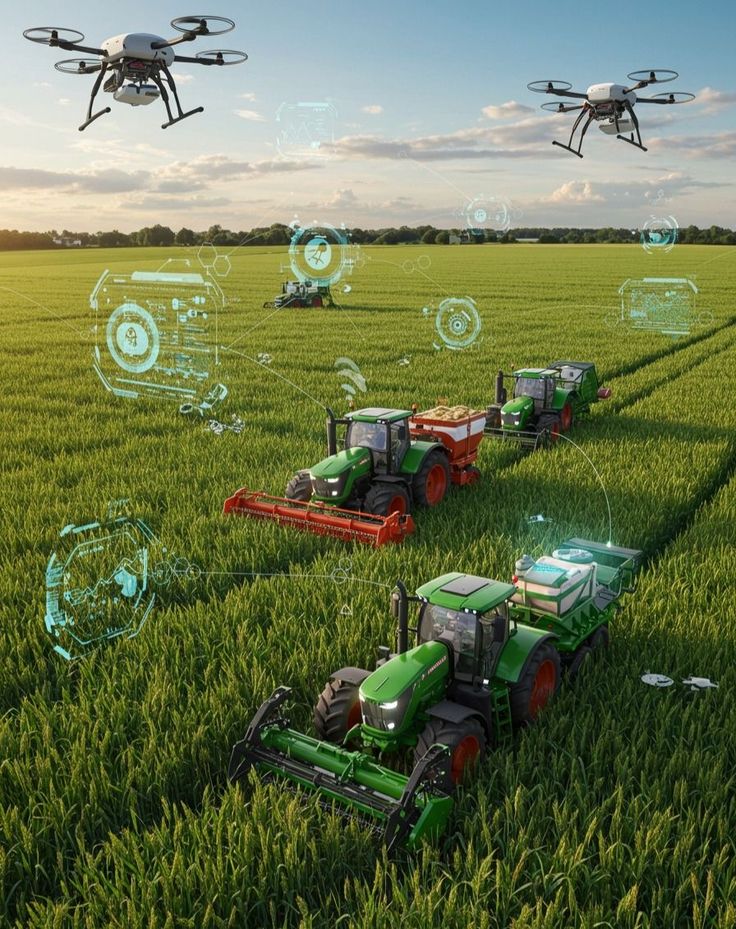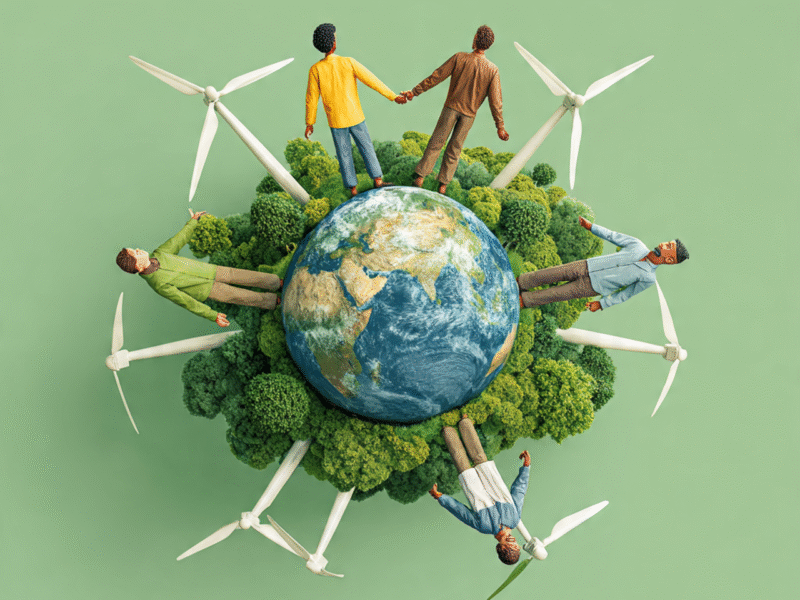
Vertical Farming and Green Technology
Today, I am presenting to you a unique and comprehensive piece on vertical farming and green technology, being written for the first time in the world. This writing will tell you how vertical farming and green technology are playing a crucial role in solving food shortages, population growth, and climate-related agricultural issues. If you like this material, please let us know, and if you need more details on any specific topic, you can contact us.
🌱 Vertical Farming: The Revolutionary Concept of Urban Agriculture
Vertical farming has fundamentally transformed traditional agricultural concepts and opened new possibilities for food production in urban areas. This method involves cultivating crops vertically across multiple layers, allowing for maximum production in limited land area. This concept of vertical farming has not only revolutionized agricultural land use but has also played a key role in water conservation, reducing the use of chemical pesticides, and achieving year-round continuous production. Modern vertical farms use hydroponic, aeroponic, and aquaponic systems, which grow plants without soil and reduce water usage by up to 95%. These systems are equipped with advanced technologies like artificial lighting, temperature control, and automated nutrient delivery, providing an ideal environment for plant growth.
The greatest feature of vertical farming is its independence from seasonal changes, enabling continuous production 365 days a year. Because of this, these systems are proving to be a strong defense against the negative impacts of climate change on agriculture. For example, Singapore’s “Sky Greens” farm is the world’s largest vertical farm, meeting a significant portion of the city’s vegetable needs. Similarly, America’s “AeroFarms” has established a vertical farming system in a 70-story building in a densely populated city like New York, producing over 2 tons of vegetables daily. These projects are not only increasing food security but are also creating new employment opportunities in urban areas.
The environmental benefits of vertical farming are also extremely important. Unlike traditional agriculture, vertical farming uses minimal to no pesticides and herbicides, significantly reducing land and water pollution. Furthermore, vertical farms can be established near cities, reducing food transportation distances and the associated carbon emissions from transit. This system also reduces food waste, as produce can be delivered directly to consumers. This revolutionary concept of vertical farming is truly laying the foundation for the future of sustainable agriculture.
💧 The Role of Green Technology in Water Conservation
Green technology has set new standards for water conservation in agriculture. Modern irrigation systems, efficient water management practices, and water reuse technologies have brought revolutionary changes to water use in the agricultural sector. Drip irrigation, sprinkler systems, and micro-irrigation methods have reduced water usage by 50 to 70%. Smart sensors and IoT devices can now accurately determine plants’ water needs and provide water accordingly. These systems not only aid in water conservation but also improve plant health and yield.
Green technologies have also played a key role in improving water quality. Water filtration systems, desalination plants, and water recycling technologies have ensured the availability of clean water for agriculture. Singapore’s “NEWater” technology is a prime example, converting wastewater into drinking water. Similarly, Israel’s drip irrigation systems have made agriculture possible in desert areas. These technologies not only help conserve water but are also strengthening food security.
Data analytics and artificial intelligence have also played a significant role in water management. Advanced software can analyze water usage, reduce water waste, and determine the optimal time for irrigation. These systems analyze weather data, soil moisture, and plant needs to form efficient irrigation schedules. These digital solutions are truly opening new pathways for water conservation and agricultural sustainability.
🌞 Alternative Energy Sources and Sustainable Agriculture
Alternative energy sources have played a key role in promoting sustainable agriculture. Solar energy, wind energy, and biomass energy have made energy use in the agricultural sector sustainable. Solar-powered irrigation systems, wind-powered pumps, and biogas plants have reduced dependence on fossil fuels in agriculture. These alternative energy sources are not only environmentally friendly but also reduce the cost of agriculture.
Solar-powered greenhouses have also played a significant role in sustainable agriculture. These greenhouses use solar energy to control temperature, humidity, and light, providing an ideal environment for plant growth. Additionally, solar-powered dryers have made the crop drying process more efficient. These systems not only help conserve energy but also improve crop quality.
Biomass energy has also played a key role in managing agricultural waste. Biogas plants convert agricultural waste into energy, which not only meets energy needs but also helps in waste management. These systems are also becoming a source of additional income for farmers. This use of biomass energy is truly the best example of a circular economy.
🍃 Biodiversity and Environmental Protection
Vertical farming and green technology have also played a vital role in protecting biodiversity. Unlike traditional agriculture, vertical farming does not require deforestation, thus preserving biodiversity. Furthermore, vertical farming systems use minimal to no pesticides, protecting terrestrial and aquatic life.
Biological control methods have also played a key role in environmental protection. The use of beneficial insects, companion planting, and other biological methods help control harmful pests. These methods are not only eco-friendly but also improve crop quality. These biodiversity conservation methods are truly the foundation of sustainable agriculture.
Green technologies have also played a key role in ecosystem restoration. Afforestation projects, soil conservation techniques, and wetland restoration have improved ecosystem health. These measures not only help protect biodiversity but also help mitigate the effects of climate change.
🌍 Food Security and Population Growth
Vertical farming and green technology have played a crucial role in addressing the challenges of food security. The world’s population is estimated to reach 9.7 billion by 2050, requiring a 70% increase in food production. Vertical farming systems can play a key role in solving this challenge. These systems can produce more in limited space, meet food needs in urban areas, and reduce food waste.
Urban agriculture projects have also played a significant role in food security. Rooftop gardens, community gardens, and urban farms have ensured the availability of fresh food in urban areas. These projects are not only increasing food security but are also creating food awareness among urban residents.
Green technologies have also improved food distribution systems. Cold chain technologies, efficient transportation systems, and digital platforms have made food delivery more effective. These systems not only reduce food waste but also improve access to food.
🔬 Advanced Trends in Research and Development
Research and development in the field of vertical farming and green technology have opened new possibilities. Genetic engineering, CRISPR technology, and advanced breeding techniques have increased the productivity of crops. These technologies are proving helpful in developing drought-resistant crops, disease-resistant varieties, and high-yield seeds.
Nanotechnology has also brought revolutionary changes to agriculture. Nano-fertilizers, nano-pesticides, and nano-sensors have made agricultural processes more efficient. These technologies not only increase production but also reduce environmental impacts.
Digital agriculture has also played a key role in the agricultural sector. Precision farming, drone technology, and satellite imaging have helped farmers make better decisions. These technologies not only improve productivity but also make resource use more efficient.
🌾 Economic Sustainability and Employment Opportunities
Vertical farming and green technology have created economic sustainability and new employment opportunities. This sector has not only become a source of additional income for farmers but has also given rise to new professions and industries. New careers such as vertical farm managers, hydroponic specialists, and agricultural technologists have emerged.
These technologies are also becoming a source of economic development for small farmers. Micro-financing schemes, cooperative farming models, and digital marketplaces have helped small farmers access markets. These initiatives are not only helpful for economic development but are also playing a key role in the fight against poverty.
Green technologies have also played a significant role in rural development. Renewable energy projects, sustainable agricultural practices, and rural infrastructure development have improved the quality of life in rural areas. These developments not only aid economic growth but are also reducing urban migration.
🌐 Global Cooperation and Future Possibilities
Global cooperation has played a vital role in promoting vertical farming and green technology. Partnerships between international organisations, research institutions, and governments have accelerated the development of this sector. Organisations like the Food and Agriculture Organisation (FAO), the World Bank, and the United Nations Development Programmed (UNDP) are supporting sustainable agriculture projects.
In the future, there are even broader possibilities for the use of vertical farming and green technology. The integration of artificial intelligence, robotics, and advanced biotechnology could bring further revolutionary changes to the agricultural sector. These developments will not only strengthen food security but will also play a key role in environmental protection.
These technologies can also play a crucial role in achieving the Sustainable Development Goals (SDGs) at a global level. Vertical farming and green technology are key to achieving goals like Zero Hunger, Climate Action, and Sustainable Cities. These technologies are truly a guarantee for humanity’s bright future.


